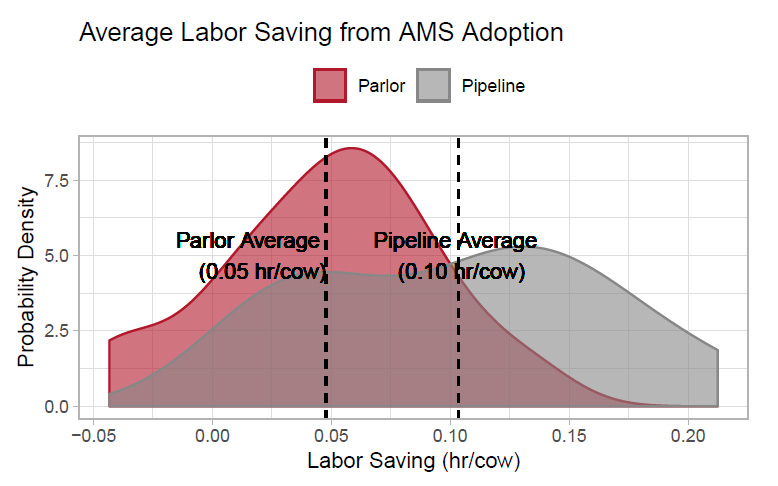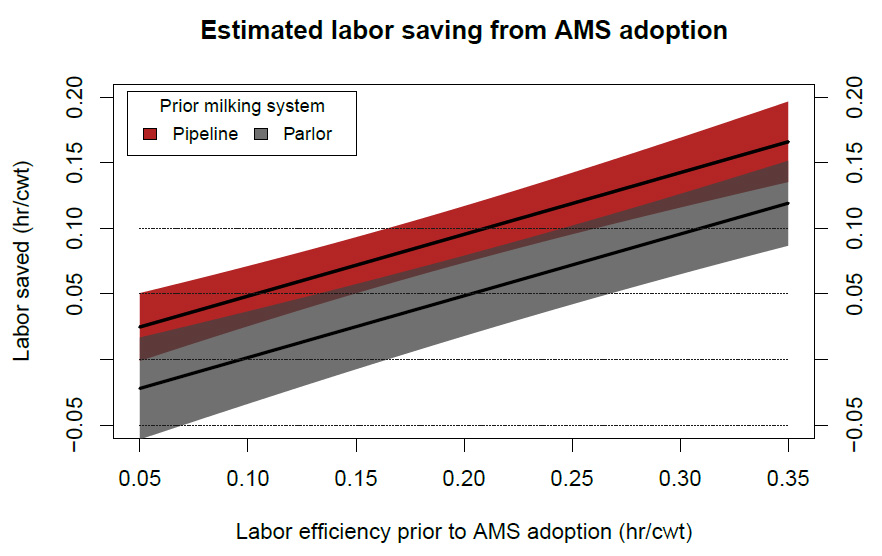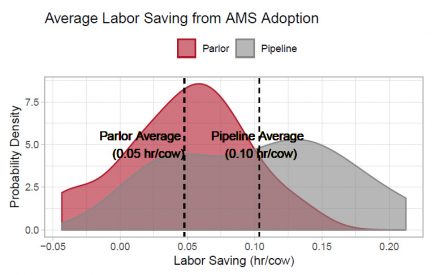When considering major changes in production technology such as the adoption of automated milking systems (AMS), identifying and quantifying the main costs and benefits is a crucial part of the planning process. Most dairy producers expect some labor savings from AMS adoption, and for some it might be the main motivation. But exactly how much labor saving can realistically be expected and what are the key factors determining those savings? To help answer these questions, this fact sheet analyses the impacts of AMS technology on labor efficiency1 as reported by 50 dairy producers from the US.
Our sample shows an average labor saving above 0.06 hr/cow/day or 0.10 hr/cwt after AMS adoption. At a wage rate of $15/hr that would amount to a cost saving of $1.5/cwt. It might also be useful to think of potential labor savings in percentage terms. Our respondents, on average, reduced the amount of time required per cow by about 38%, and the time required by hundredweight by about 43% as AMS adoption usually increases production per cow.
There was large variations in the labor saving reported. At the lower end, around 8% of our respondents reported no labor savings at all. Many of those respondents cited maintenance and repair issues as a primary concern and a source of unexpected/additional labor needed to run the AMS. At the other end of the spectrum, 25% of our respondents reported labor savings above 0.10hr/cow or 0.16hr/cwt ($2.4/cwt assuming a wage of $15/hr).
A major determinant of labor saving is the original milking system that the AMS is replacing. The figure above shows the distribution of labor saving for respondents that used AMS to replace a parlor system and those that used AMS to replace a pipeline system. Those that had a parlor saved 0.08hr/cwt on average while those with a pipeline saved 0.16hr/cwt on average.
Other factors affecting labor saving
A few other factors a˙effecting labor saving could be identified. First, those that opted for new housing, instead of retrofitted, experienced higher labor savings (by about 0.04hr/cwt or $0.5/cwt at a wage of $15/hr).
This might be due to the benefits of modern housing with respect to the ease of bedding, feeding, and handling cows, and to the higher production associated with new housing.
Herd size had a very modest but positive impact on labor saving. That is, after controlling for other factors, larger herds have experienced slightly higher labor savings. This could suggest some modest economies of scale in managing AMS systems.
A farm’s labor efficiency prior to AMS adoption is a major determinant of the level of expected labor saving. The figure below shows the positive relationship between a farm’s initial efficiency level and the estimated labor saving depending on whether it transfers from a parlor system or a pipeline system.
Producers Comments
- “Anyone considering robotics should understand that there is still plenty of daily work involved in milking, robots just give you more flexibility with your time”
- “Still need experienced labor to keep robots running.”
- “AMS is not stress free. Physically it is easier. Mentally stressful.”
The Survey
The survey was jointly conducted by the Extensions of Wisconsin, Minnesota, and Pennsylvania. We thank those who provided their inputs to our survey, and we continue to invite others who are also operating automatic milking systems (AMS). The online survey is available at z.umn.edu/DairyRobotSurvey.
Contact
Simon Jette-Nantel – University of Wisconsin, River Falls – simon.jettenantel@wisc.edu
Kota Minegishi – University of Minnesota, Twin Cities – kota@umn.edu
1Labor efficiency was calculated as the total number of hours of labor per day(employee and owner) for the milking herd (including milking, feeding, bedding, breeding, treating, cleaning, etc.) divided by either the avreage herd size to get hr/cow, or by the average herd milk production to get hr/cwt. Among our respondents, labor efficiency ranged from 0.20 hr/cow or 0.28 hr/cwt for the least efficient 20% to 0.07 hr/cow or 0.10 hr/cwt for the top 20%.

Download Article




 Labor savings from adopting automated milking systems
Labor savings from adopting automated milking systems Farm employment in Wisconsin
Farm employment in Wisconsin Understanding the Total Compensation Statement Benefits Everyone
Understanding the Total Compensation Statement Benefits Everyone Large Language Models: A Powerful New Tool for Wisconsin Agriculture
Large Language Models: A Powerful New Tool for Wisconsin Agriculture


